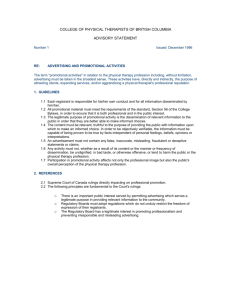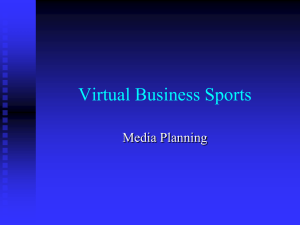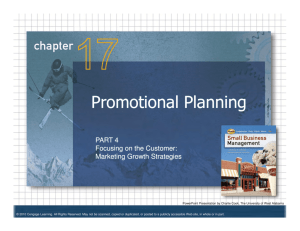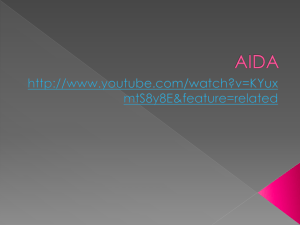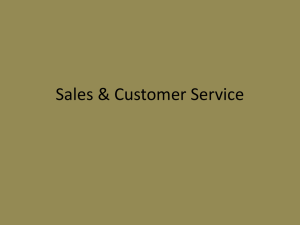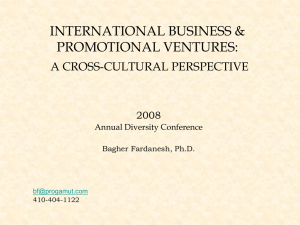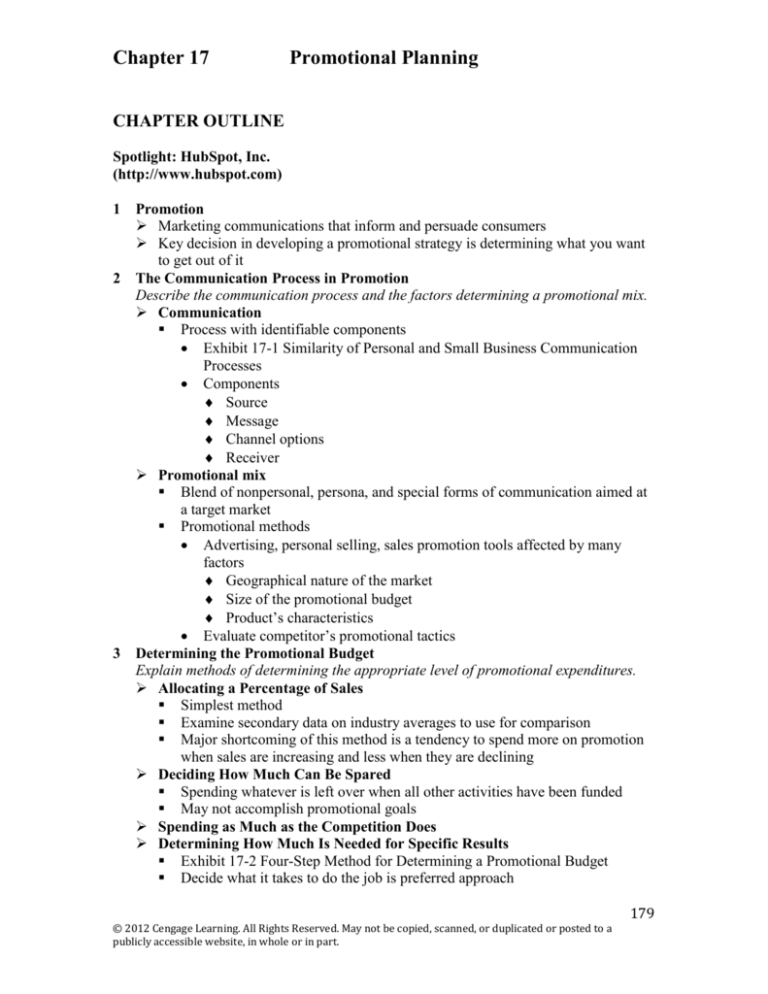
Chapter 17
Promotional Planning
CHAPTER OUTLINE
Spotlight: HubSpot, Inc.
(http://www.hubspot.com)
1 Promotion
Marketing communications that inform and persuade consumers
Key decision in developing a promotional strategy is determining what you want
to get out of it
2 The Communication Process in Promotion
Describe the communication process and the factors determining a promotional mix.
Communication
Process with identifiable components
Exhibit 17-1 Similarity of Personal and Small Business Communication
Processes
Components
Source
Message
Channel options
Receiver
Promotional mix
Blend of nonpersonal, persona, and special forms of communication aimed at
a target market
Promotional methods
Advertising, personal selling, sales promotion tools affected by many
factors
Geographical nature of the market
Size of the promotional budget
Product’s characteristics
Evaluate competitor’s promotional tactics
3 Determining the Promotional Budget
Explain methods of determining the appropriate level of promotional expenditures.
Allocating a Percentage of Sales
Simplest method
Examine secondary data on industry averages to use for comparison
Major shortcoming of this method is a tendency to spend more on promotion
when sales are increasing and less when they are declining
Deciding How Much Can Be Spared
Spending whatever is left over when all other activities have been funded
May not accomplish promotional goals
Spending as Much as the Competition Does
Determining How Much Is Needed for Specific Results
Exhibit 17-2 Four-Step Method for Determining a Promotional Budget
Decide what it takes to do the job is preferred approach
© 2012 Cengage Learning. All Rights Reserved. May not be copied, scanned, or duplicated or posted to a
publicly accessible website, in whole or in part.
179
Chapter 17
Promotional Planning
4 Personal Selling in the Small Firm
Describe personal selling activities.
The Importance of Product Knowledge
The Sales Presentation
Using Prospecting Techniques
Personal referrals
Impersonal referrals
Marketer-initiated contacts
Customer-initiated contacts
Practicing The Sales Presentation
Improves the salesperson’s success rate
Consider possible customer objections to the product and prepare to
handle them
Price
Product
Timing
Source
Service
Need
Factually untrue objections may be handled by
Direct denial
Indirect denial
Answering objections with the words feel, felt, and found; don’t argue
Take notes (shows you are listening)
Compensation method (admit to agreeing with the objection then
proceed to show compensating advantages)
Pass-up method (acknowledge concern expressed and then move on)
Find the true objection (ask for more details to determine how to
handle the objection)
Follow up and follow through (may be used to defer a decision)
Making The Sales Presentation
Adapt the sales approach to meet customers’ needs
Canned sales approach will not succeed with most buyers
Successful selling involves psychological elements (personal enthusiasm,
friendliness, persistence)
Cost Control in Personal Selling
Cost for outside sales calls may be high
Especially important to control costs for a new business with limited resources
The Compensation Program for Salespeople
Nonfinancial compensation
Personal recognition and satisfaction of reaching sales quota
Personal and career advancement
Financial Compensation
Two basic plans
Commissions
180
© 2012 Cengage Learning. All Rights Reserved. May not be copied, scanned, or duplicated or posted to a
publicly accessible website, in whole or in part.
Chapter 17
Promotional Planning
Preferred by small businesses
Approach is simple and directly related to productivity
Straight salary
More income security
Can potentially reduce a salesperson’s motivation by providing
income despite low performance or no sales at all
Combination of commission and straight salary most attractive plan
for most small businesses
5 Advertising Practices for Small Firms
Identify advertising options for a small business.
Advertising Objectives
Advertising is impersonal presentation of a business idea through mass media
Primary goal to sell by informing, persuading, and reminding customers of the
availability or superiority of a firm’s product or service
Must always be viewed as a complement to a good product and never as a
replacement for a bad product
Avoid creating false expectations with advertising
May seem to be a waste of money, but is the primary alternative to personal
selling which is more expensive and time-consuming
Types of Advertising
Product Advertising – the presentation of a business idea designed to make
potential customer aware of a specific product or service and create a desire
for it
Institutional advertising – the presentation of information about a particular
firm, designed to enhance the firm’s image
Obtaining Assistance with Advertising
Advertising agencies, suppliers, trade associations, advertising media
Ad agencies provide services such as:
Furnish design, artwork, and copy
Evaluate and recommend the ad media with greatest “pulling power”
Evaluate the effectiveness of different advertising appeals
Advise on sales promotions and merchandise displays
Conduct market-sampling studies to evaluate product acceptance or
determine the sales potential of a specific geographic area
Furnish mailing lists
Frequency of Advertising
Important and highly complex issue for small businesses
Should be done regularly
Part of an ongoing promotional program
Where to Advertise
Most small firms restrict either geographically or by customer type
Media should reach, but not overreach, firm’s present or desired target market
Combination of media depends on type of business and its current
circumstances
Exhibit 17-3 Advantages and Disadvantages of Major Advertising Media
Web Advertising
© 2012 Cengage Learning. All Rights Reserved. May not be copied, scanned, or duplicated or posted to a
publicly accessible website, in whole or in part.
181
Chapter 17
Promotional Planning
Basic methods of Web Advertising for a small firm are:
Company website
Banner ads and pop-ups
E-mail
Reciprocal advertising and hyperlinks
Blogs
Creating and Registering a Site Name
Building a User-Friendly Website
See exhibit 17.4 (Website Essentials)
Promoting the Website
Banner Ads and Pop-Ups
Often carried out through an affiliate program
Some skepticism about the cost effectiveness of these ads
Price comparison pop-ups an effective way to lure surfers from
competitors’ websites
Direct E-Mail Promotion
Advertising delivered by means of electronic email
Low-cost method to pinpoint customers and achieve response rates higher
than those for banner ads
Increasing in use
Two obstacles
Can-Spam Act of 2003 by Congress
Anti-spam software
Reciprocal Advertising and Hyperlinks
Hyperlink is a word, phrase, or image that a user may click on to go to
another part of a document or website or to a new document or website
Blogs
An interactive website where an individual can maintain a personal online
journal, post and receive comments and reflections, and provide
hyperlinks
Companies that ignore blogging do so at their own peril
Mobile Devices
a generic term used to refer to a variety of wireless handheld
computing devices
APPS
abbreviation for a software application for business or entertainment
Social Media
Websites and applications used for social networking
Social networking- the use of dedicated websites and applications
communicate informally with other users.
Web 2.0 – a term referring to the second generation of the World Wide
Web, which allows for online collaboration of social interactions, and
information sharing
6 Sales Promotional Tools
Discuss the use of sales promotional tools.
182
© 2012 Cengage Learning. All Rights Reserved. May not be copied, scanned, or duplicated or posted to a
publicly accessible website, in whole or in part.
Chapter 17
Promotional Planning
Specialties
Calendars, pens, key chains, coffee mugs, and shirts
Enduring nature and tangible value
Personal, distributed directly to the customer
Trade Show Exhibits
Possible path to international markets
Tips for trade shows
Check out the trade show’s history
Prepare a professional-looking display
Have a sufficient quantity of literature on hand
Make sure you have a good product
Do pre-show promotion
Have a giveaway or gimmick
Train booth personnel
Follow up!
Publicity
Provides visibility for a business at little or no cost
Not always free, relatively small investment
Examples: underwriting school yearbooks, sponsoring youth athletic
programs, social shopping websites
When to Use Sales Promotion
Based on business objectives
Based on effective communication
SOURCES OF VIDEO AND OTHER INSTRUCTIONAL MATERIALS
The Sales Connection is a video series produced by INTELECOM that includes 26
half-hour segments featuring leading sales and business experts. Visit their Web site
at http://studentstore.intelecomstore.org.
ANSWERS TO END-OF-CHAPTER DISCUSSION QUESTIONS
1. Describe the parallel relationship that exists between a small business
communication and a personal communication.
The basic structure is the same. Each involves a source, a message, a channel,
and a receiver. The difference between personal and small business
communication is in the form of the communication elements. Figure 17-1 in
the chapter depicts the similarity, as well as these differences in form.
2. Discuss the advantages and disadvantages of each approach to budgeting
funds for promotion.
© 2012 Cengage Learning. All Rights Reserved. May not be copied, scanned, or duplicated or posted to a
publicly accessible website, in whole or in part.
183
Chapter 17
Promotional Planning
a. Using a percentage of sales is simple and quick; the disadvantage is that a
business spends more when sales are increasing but less when sales are
declining.
a. Spending what can be spared requires no knowledge of promotion to set the
budget; its disadvantage is that it is not an organized approach.
b. Spending as much as the competition does requires little knowledge of how
promotion works; the disadvantage is that the competition may be
promoting ineffectively, so a business that copies the competition may be
copying a mistaken approach.
d. Spending what it takes to do the job is most consistent with the goals of
promotion; the disadvantage is that it is a time-consuming approach and
requires a greater understanding of promotion.
3. Outline a system of prospecting that could be used by a small camera store.
Incorporate all the techniques presented in this chapter.
A list of prospects could be compiled by asking current customers about their
friends who are interested in photography; obtaining mailing lists compiled by
magazines in the field; noting responses to coupons or other promotional
efforts, such as contests; identifying names of customers who have just walked
into the store; monitoring the newspapers, photography club activities, and so
on; and identifying names on film-developing envelopes.
4. Why are a salesperson’s techniques for handling objections so important to a
successful sales presentation?
They are important for two principal reasons. First, objections are negatives.
An objection is an escape for the prospect. The salesperson must shut the door
on this exit. Second, there is little or no time during the presentation itself to
prepare a response to objections. Thus, the preparation of techniques becomes
vital.
5. Assume you have the opportunity to “sell” your course instructor on the idea
of eliminating final examinations. Make a list of the objections you expect to
hear from your instructor and describe how you would handle each objection,
using some of the techniques listed on pages 505-506.
Answers to this question will vary. Following are examples of some of the
points that may be presented and possible objections for each:
Instructor Objection
“Exams are good learning tools.”
“I must have something to measure what
you
have learned.”
184
Student Response
“Not having exams leaves more days to
listen to your wonderful lectures.”
“Exams do not measure what we really
have learned. Trust your judgment.”
© 2012 Cengage Learning. All Rights Reserved. May not be copied, scanned, or duplicated or posted to a
publicly accessible website, in whole or in part.
Chapter 17
Promotional Planning
“The school requires documentation for a “We won’t tell!”
grade.”
6. What are some nonfinancial rewards that could be offered to salespeople?
The following might reward and motivate salespeople:
An all-expenses-paid vacation
A salesperson-of-the-month contest featuring display of the winner’s
picture and name in the office
A billboard displaying the name of the top salesperson of the year
Use of a luxury car for one month
A better office
A service pin awarded to top performers
7. What are the advantages and disadvantages of compensating salespeople by
salary? By commissions? What do you think is an acceptable compromise?
Security for the salesperson is the greatest advantage of a salary plan. A straight
salary makes it easier for the firm to require non-selling activities from its sales
force. This method, however, does tend to restrict the earning ability of
salespeople and can reduce their motivation.
A commission plan allows salespeople to make as much money as their abilities
will allow. It also gives strong incentive to the sales force. A commission plan,
however, means “no sale, no income.”
A combination of the two forms of compensation can give the small business
the best of both worlds.
8. What are some approaches to advertising on the Web?
Basic methods of Web advertising include (1) establishing a corporate Web site
and (2) creating banner ads and pop-ups, (3) using direct e-mail promotions,
and (4) taking advantage of sponsorships and linkages. Establishing a Web site
places information about the firm and its products/services in a place where
potential customers can find it. With banner ads and pop-ups, the firm takes its
message to the customer by posting advertisements on Web pages where
potential buyers can see them and respond. Using direct e-mail promotions is
a very inexpensive way to get the word out, but target consumers are becoming
more resistant to this form of advertising. By sponsoring a Web page for
another organization and perhaps even featuring a click-on link to its own site,
a firm can sometimes reach customers.
9. Discuss some recommendations for designing an effective web site.
Because first impressions are so important a small firm’s Web site needs to be
attractive and inviting. Exhibit 17-4 on page 511 of the chapter lists ten Web
site design tips. Students will surely use these as part of their answer. However,
© 2012 Cengage Learning. All Rights Reserved. May not be copied, scanned, or duplicated or posted to a
publicly accessible website, in whole or in part.
185
Chapter 17
Promotional Planning
encourage them to expand the list and provide example Web sites for each
suggestion they make.
10. How do specialties differ from trade show exhibits and publicity? Be specific.
Specialties are different from trade show exhibits in that the former are enduring
representations of the firm and its message, whereas trade show are
experientially-based (i.e., they are time-constrained opportunities to create an
impression and present information about the firm). These options always
involve some cost. However, publicity works through various media to
promote an image about the firm and it is often (though not always) free.
COMMENTS ON CHAPTER “YOU MAKE THE CALL” SITUATIONS
Situation 1
1. What do you think about giving away a product? Does it build sales, or does
it suggest desperation?
Product sample giveaways are an excellent way of connecting directly and
personally with the customer. The company has the advantage of observing an
immediate reaction from the customer- good or bad. The company can also
take advantage of “impulse buying” should they have a great product. Sample
giveaways is a growing trend and indeed builds sales as evidenced by the
growing number of companies who sample their products on weekends at
Costco.
2. How would you budget for marketing expenses if you had hired sales
representative to give products away?
One would utilize the same four-step method for determining the promotional
budget.
Allocate a percentage of sales
Decide how much can be spared
Spend as must a the competition
Determine how much is needed for specific results
Once data on the four steps above has been gathered, compare the numbers,
make a decision and implement a promotional budget. In this case, the cost of
the sales representative would be included in this budget. Depending on the
level or detail and complexity of the item, a sales representative may be needed.
For simple food items, a sales representative would not be needed and a less
costly employee could give away the samples. In this case no selling or
complex / detailed explanation about the product would be needed
186
© 2012 Cengage Learning. All Rights Reserved. May not be copied, scanned, or duplicated or posted to a
publicly accessible website, in whole or in part.
Chapter 17
Promotional Planning
3. What are some of the ways you might compensate your “brand
ambassadors”? Which method do you think would work best and why?
A combination of financial and nonfinancial compensation should be
employed. Nonfinancial rewards in the form of career advancement,
recognition, and advanced education and training could be offered. Financial
compensation should be a blend of salary and commission. The ratio should be
adjusted as the brand ambassador proves their sales skills to the company.
Situation 2
1. What suggestions can you offer that would help Moore make this decision?
If the advertisements are of high quality and colorful, they should be attentiongetting. The firm actually used full-scale ads covering the entire side of the
trucks (9 ft. by 48 ft.). The image concern is an important consideration but
should not be a problem for this product. It is likely that Moore will want to
avoid some trucking companies—those from insecticides or animal product
companies, for example.
2. How could Moore go about determining the cost-effectiveness of this
strategy?
Moore offered a trucking firm approximately $1,500 for the privilege to
advertise on 25 of its trucks for three years. Using these cost figures, some
exposure data provided by the American Trucking Association, and a reference
showing that 90 percent of survey respondents notice truck advertising, Moore
estimated that she is paying only 21 cents per thousand exposures.
3. What additional factors should Moore evaluate before advertising on trucks?
One concern is a legal one. Does the Department of Transportation allow this
type of advertising on the trucks it regulates? With certain restrictions, Moore’s
ads were acceptable to the department’s Bureau of Motor Carrier Safety.
Moore also had to evaluate whether the trucks would be traveling into markets
where the salad products were not distributed. In fact, Moore received calls
from people who had seen the truck advertising but could not find the product.
Situation 3
1. There is more than a 10-year age difference between members of Panchero’s
top management team and Joel Johnson. Do you think that difference could
have contributed to Johnson’s effectiveness in social networking? Why or
why not?
© 2012 Cengage Learning. All Rights Reserved. May not be copied, scanned, or duplicated or posted to a
publicly accessible website, in whole or in part.
187
Chapter 17
Promotional Planning
The age difference probably made a difference in the beginning of this
process. However once the top management team learns how do handle this
type of social networking they eventually could become comfortable with it.
2. Is it ethical for Johnson to be recommending the restaurant chain where he
works? Why or why not?
It is ethical as long as he doesn’t hide that fact from the people he talks to on
Twitter, Facebook, and the other sites.
3. Have you ever posted any comments on a website about a business that you
have visited? Do you check for customer comments before you shop at a
particular business?
Students will provide individual comments on these questions.
SUGGESTED SOLUTION TO CASE 17: HUBSPOT, INC.
1. How has the salesperson’s role changed because of Internet marketing? Consider
differences in prospecting and presentation.
The internet has added an additional layer to the promotional mix. Today’s promotional
mix is a blend of non-personal, personal, and special forms of communication aimed at
the target market.
Prospecting is a systematic process of continually looking for new customers. A sales
presentation is a form of personal selling and requires the sales person to make a perfect
oral delivery of the product.
Prospecting techniques vary. There are personal referrals which are referrals that come
from friends, customers and other businesses. Another technique is impersonal referrals
which come from media publications, public records, and directories. Prospects can also
be identified through marketer-initiated contacts. These are telephone calls or mail
surveys to help locate possible buyers.
Sales presentations give the salesperson the opportunity to respond to questions
immediately. Successful salespeople should develop the following techniques:
The ability to respond to a direct denial
The ability to respond to an indirect denial
The ability to answer objection with the words, feel, felt, and found
Take notes
Show compensating advantages
Find the true objection
188
© 2012 Cengage Learning. All Rights Reserved. May not be copied, scanned, or duplicated or posted to a
publicly accessible website, in whole or in part.
Chapter 17
Promotional Planning
Follow up and follow through
2. Do you agree with HubSpot that a prospect is more “qualified” to make purchasing
decision when it uses information found on the Internet?
Yes, possibly. Because HubSpot can control the content and accuracy of their website
content, they can educate their customer accurately. Therefore, the buyer has all the
information they need to make an informed and intelligent buying decision.
3. How might the salesperson’s compensation be different or the same with Internet
sales versus traditional sales methods?
Traditional sales methods allow the sales person to personally connect with the customer.
The customer can enjoy the personal enthusiasm of the sales person. The sales person
can also utilize their personally crafted selling techniques. HubSpot will need to evaluate
the cost/benefit of sales garnered via this medium versus the impersonal selling of the
internet. Certainly it would seem reasonable to compensate the sales person at a higher
rate of commission for adding value to the sales experience of the customer.
4. Should a new small business rely solely on Internet promotions? What other
methods should it use?
Small businesses like HubSpot should be concerned with changes in technology and
societal behavior and not rely exclusively on internet promotions. Two basic types of
advertising are:
Product advertising which is designed to make potential customers aware of a
particular product or service and create a desire for it.
Institutional advertising which conveys information about the business itself. It is
intended to make the public aware of the company and enhance its image so that
its product advertising will be more credible and effective.
Where to advertise presents lots of options such as:
Newspapers
Magazines
Radio
Television
Outdoor media
Internet
Within the internet there are also several opportunities for advertising such as:
Banner ads and pop-ups
Direct e-mail promotions
© 2012 Cengage Learning. All Rights Reserved. May not be copied, scanned, or duplicated or posted to a
publicly accessible website, in whole or in part.
189
Chapter 17
Promotional Planning
Reciprocal advertising and hyperlinks
Blogs
Mobile devices
Apps
Social media
HubSpot will want to carefully design an advertising campaign that reaches its target
market and likely, they will have to modify it as they learn of its effectiveness and
ineffectiveness.
190
© 2012 Cengage Learning. All Rights Reserved. May not be copied, scanned, or duplicated or posted to a
publicly accessible website, in whole or in part.


